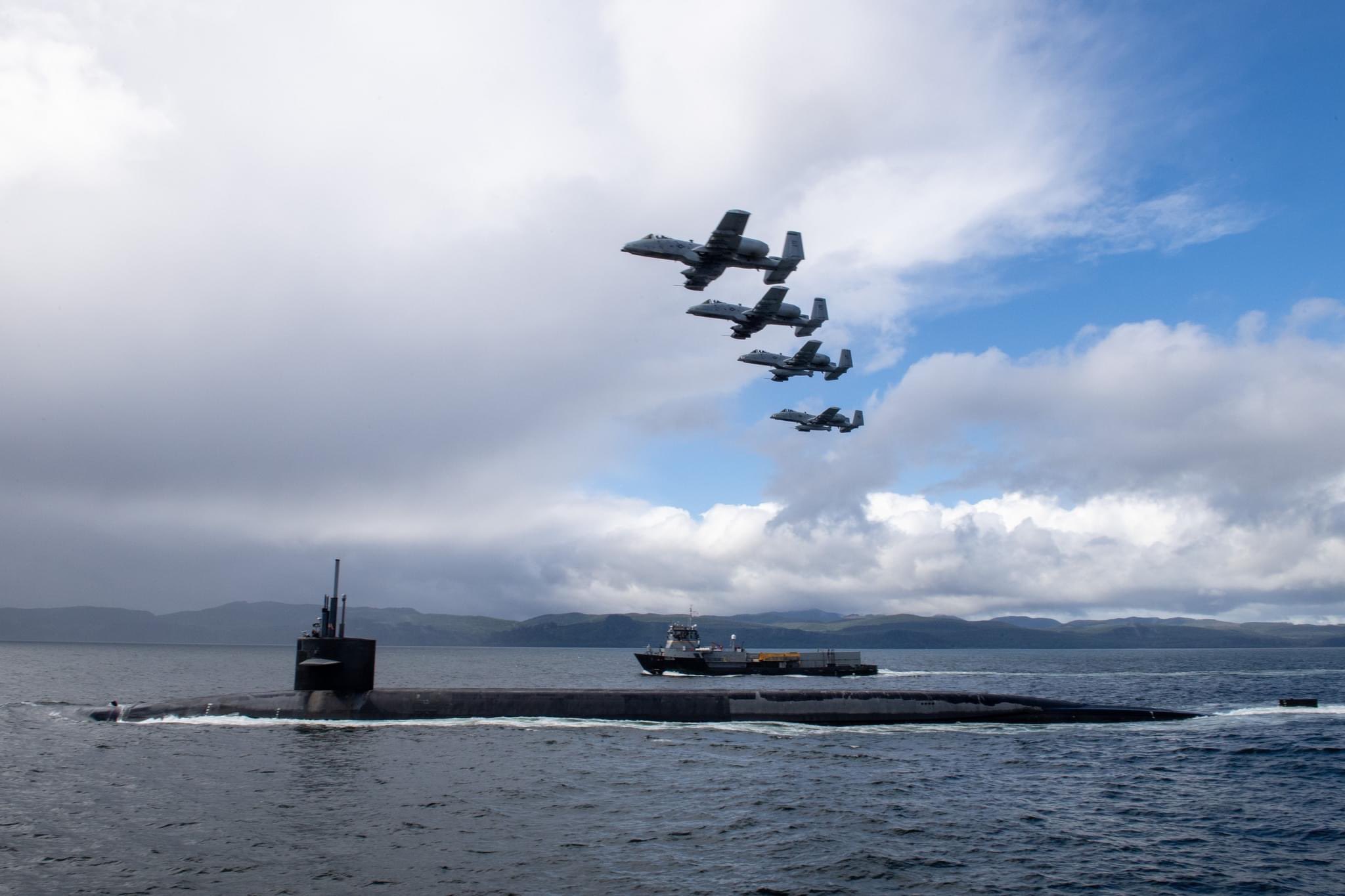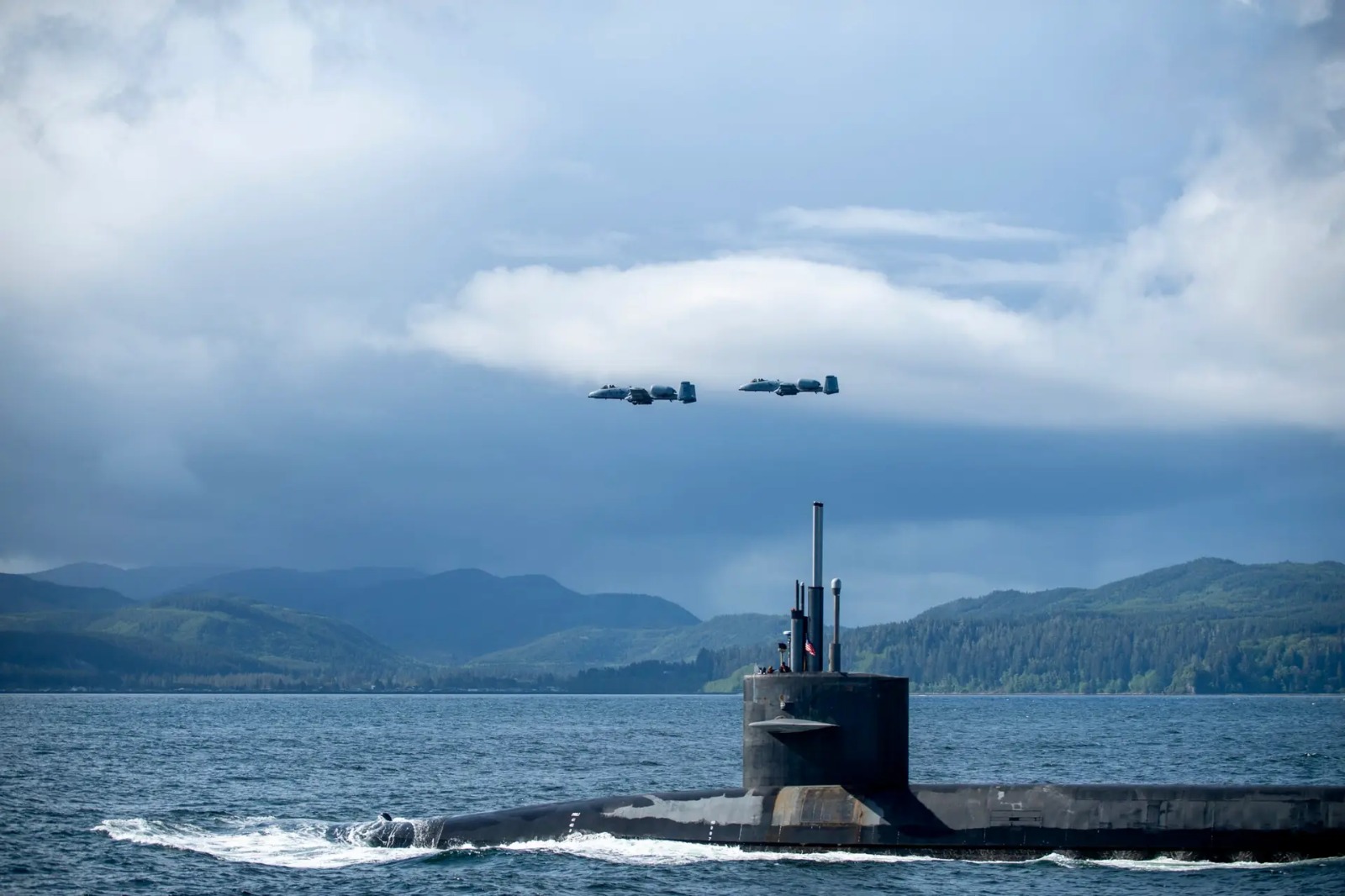Inching towards retirement, the U.S. Air Force’s A-10 Thunderbolt II ‘Warthog’ had an unusual sighting. Four ‘Tank Killer’ and Close Air Support (CAS) aircraft were seen escorting a U.S. Navy’s Ohio class ballistic submarine USS Nebraska.
The mission of the Warthog was unclear, but the photographs of the quartet of A-10s hovering over the USS Nebraska on social media did generate some buzz. The images were released on social media by Commander Submarine Group 9 at Naval Base Kitsap, Washington state.
The visual depicts USS Nebraska and its escorts transiting the Strait of San Juan de Fuca, the Salish Sea’s main outlet to the Pacific Ocean, on May 6.
Nebraska is one of the U.S. Navy’s 14 Ohio class ballistic missile submarines (SSBNs), also known as ‘boomers,’ which form the sea-based leg of America’s nuclear deterrence triad. The Navy also has four other Ohios, converted into conventionally armed guided missile submarines (SSGNs).
The Air Force intends to retire all A-10s over the next five or six years. In 2023, the USAF retired 21 A-10s, reducing its inventory from 281 to 260. The Air Force aims to continue this momentum, eventually phasing out all the A-10s from its inventory.

The main reason behind the retirement of the aircraft is that despite its close air support role in Iraq and Afghanistan, the low and slow-flying A-10 would not survive against modern air defenses like that of China.
To sustain future conflicts, the USAF needs versatile aircraft capable of multiple roles. Combatant commands have not been actively requesting A-10s, and the Air Force considers it a “single-mission airplane.”
In 2023, in a bid to increase the aircraft’s versatility, a pair of A-10s were integrated with warships in the Gulf of Oman for a live surface combat patrol. This operation showcased the Warthog’s proficiency in utilizing joint fires against surface threats, an area traditionally not associated with the platform, suggesting a shift towards a more diverse operational use.
Hence, the latest visuals of the unusual pairing of A-10s with the USS Nebraska do evoke intrigue. In the photos, four A-10s, along with Special Warfare Support Vessels armed with an automatic cannon on its bow, are seen escorting the submarine. The vessels are a common form of protection when strategic submarines come and go from their home ports. But the A-10s are not.
Two of them sported ‘O.T.’ tail codes, used by Nellis Air Force’s Base’s 422d Test and Evaluation Squadron, while the remaining two had ‘K.C.’ tail codes used by the Whiteman Air Force Base’s 442nd Fighter Wing. The A-10 did not have external ordnance. The platform boasts 11 store pylons, allowing for an external load capacity of roughly 7,000 kg, including the capacity to carry up to ten Maverick air-to-surface missiles.
The Commander Submarine Group 9’s post read: “Yesterday, the Ohio-class ballistic missile submarine USS Nebraska (SSBN 739) transited the Strait of San Juan de Fuca escorted by U.S. Air Force A-10 Thunderbolt II aircraft and U.S. Coast Guard screening escort vessels.
Joint operations, such as this one involving the Air Force, Coast Guard, and Navy, ensure the U.S. military is ready to meet its security commitments at home and abroad, including commitments to our allies and partners.”
Although more information about the exercise is unavailable, the A-10s most likely were used as a chance to drill ‘overwatch’ and the defense of a strategic asset.
The Warthog is a highly effective force-protection platform due to its low flying, slow speed characteristics, exceptional air-to-ground precision, and loitering capacity.
In previous training exercises, A-10s have been deployed to target boat swarms and strike small naval vessels, making use of their exceptional capabilities. Boomers may precisely encounter these kinds of asymmetric risks while traveling on the ocean’s surface.
Warthog To Boneyard
The most notable feature of A-10s is General Electric’s GAU-8 30mm rotary cannon. Mounted on its nose, the Gatling gun is a one-of-a-kind weapon. Its rapid bursts, seven barrels firing 65 rounds per second, have turned “an enemy soldier’s bowels to water.”
The aircraft was conceived after the debacle of the U.S. aircraft in providing close air support to its ground troops. The A-10 flew for the first time on May 10, 1972, as the Vietnam War was winding down.
The USAF has been waging a long war to send the 1970s-era planes to the boneyard, saying it will save roughly $4 billion in operating costs. They contend that A-10 missions can be achieved by other aircraft, including the F-35.
However, the U.S. Congress has vetoed it repeatedly, primarily because of technical delays and cost overruns in the F-35 development program.

Those favoring mothballing the A-10s contend that the airplane is excellent in an uncontested environment. And they remain ambivalent about how it will perform in more contested environments in the future.
After decades of wrangling, the U.S. Congress approved the retirement of 21 A-10s in the 2023 fiscal year. The National Defense Authorization Act would allow the Air Force to mothball 21 of its fleet of 281 A-10 aircraft. It is the first time lawmakers have not intervened to prevent the Air Force from retiring A-10s in roughly a decade.
A-10 – From ‘A Leprous Project Led By A Pariah’ To Becoming The Military’s Favorite Plane
The USAF had deployed F-5 Phantoms and F-111s in Vietnam, but both failed to perform at low speeds. Then, the Fairchild Republic came in with a design for an unusual aircraft that was nearly as long as it was wide.
The fuselage was little more than a massive 30mm rotary cannon with a cockpit stuck on top. It was called “a leprous project led by a pariah” (Robert Coram in the book titled ‘Boyd.’)
The A-10 specifications team interviewed every pilot who flew during the Vietnam War and forward air controller. They all prioritized long loiter time, good range, excellent visibility, low-and-slow maneuverability, survivability, and lethal weapons. Thus came the A-10 Thunderbolt II, which valued “resiliency” and “function” over all else.
For years, it was ignored as a stepchild of its F-plane playmates. A-10 was a shotgun marriage of World War II technology, turbofan engines, and massive artillery. The pilots had expected a smaller, lighter, more maneuverable airplane than what the Warthog turned out to be. The single-seater aircraft was a simple airplane, and until post-production upgrades happened in 1989, it lacked an autopilot. It did not even have a radar.
Another thing that the pilots did not favor was that it was painfully slow. It can do just over 365 knots but usually flies strikes at 300 knots or less. The jokes are that A-10s don’t have instrument panel clocks; they have calendars, and bird strikes from behind are a significant risk.
In the 1980s, when A-10 was deployed in West Germany at the peak of the Cold War, the flying branch predicted that if the A-10s went into action, seven percent of the jets would be lost per 100 sorties, translating to at least 10 A-10s being shot down every 24 hours. Contrary to the prediction, only seven Warthogs have been shot down or crashed during combat.
The first Gulf War gave A-10s a second lease of life as they busted through tanks belonging to Saddam Hussain. It turned out to be the most potent armor-killer ever to fly.
The A-10 was also designed around a specific weapon—the General Electric GAU-8/A seven-barrel Gatling cannon, which, with its vast 1,174-round ammunition drum (mounted behind the pilot), is as big as a car. It fires 30mm cartridges nearly a foot long.
After its success in Operation Desert Storm, the aircraft earned many monikers like ‘Warthog,’ ‘Flying Gun,’ and ‘Tank Buster.’ It was later deployed in support of NATO operations in Kosovo, as well as in Operation Enduring Freedom in Afghanistan and Operation Iraqi Freedom.
Its high survivability made it highly popular with pilots. It is effective as it can loiter near battle areas for extended periods and operate in low ceiling and visibility conditions.
A-10s are all set to be replaced by Lockheed Martin’s multi-role fighter F-35 Lightening II. But every pilot who has flown the A-10 makes a strong case for its prowess. They say Warthog is affordable to fly, is already in operation, and has a greater loitering capability that the F-35 will always lack.
- Ritu Sharma has been a journalist for over a decade, writing on defense, foreign affairs, and nuclear technology.
- The author can be reached at ritu.sharma (at) mail.com
- Follow EurAsian Times on Google News




